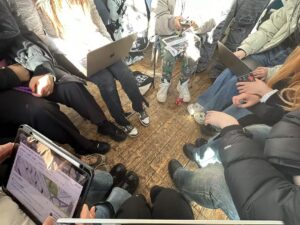
This week our Collective meeting discussed artists and their artwork related to the theme.
I propose the artist and the artwork:
1.《mAcHiNe E.L.F.》
Since the 1970s, Tony Oursler has been a pioneer of new media art, exploring the intersection of technology, mental states and society through multimedia installations, moving images and immersive environments. In mAcHiNe ELF (2023), Tony Oursler combines painting, print collage, digital projection and a large-scale optical crystal installation to explore the intersection of technology, science and mystical beliefs.
Digital Silhouettes and Collages: The work incorporates embedded screens and classic silhouettes to counter contemporary technological anxieties and conspiracy thinking, such as 5G fears and cold fusion utopias, as well as embedded ‘Easter Eggs’ that symbolise the intersection of science and magic.
Crystal Installation: Inspired by the seven basic crystal structures, the installation uses transparent mirrors and refractive screens to project rotating images, symbolising the precision of science and technology and the belief in mystical energy.
Core Themes: Oursler combines AI images, archival footage and performances to explore the digital sublime, melting ice, four-dimensional creatures, Extremely Low Frequency (ELF), and near-death experiences.
Oursler argues that science is being transformed into myth as the public becomes alienated from professional science. In his exhibition he seeks to reveal this process, both critiquing the mystification of science and technology and acknowledging the fascination of the unknown. Link to full work:
Other peers’ thoughts:
2.Mat Collishaw is a famous British contemporary visual artist. He was an important member of the ‘Young British Artists’ (YBAs) movement in the 1980s.
His works often involve themes such as illusion, perception manipulation, violent aesthetics, and historical image reproduction, and uses various media such as photography, mechanical devices, AI-generated images, and optical art to create his works.
The Centrifugal Soul 2016
It is a zoetrope installation that explores the relationship between visual perception, desire and evolutionary psychology. At the heart of the work is a giant rotating sculpture that uses the principle of Victorian zoetropes to synchronise rapid rotation with flash photography to create a fluid dynamic effect in a static sculpture. The work not only showcases the‘performative aesthetics’ in the natural world, but also metaphorically represents contemporary culture’sfascination with visual spectacle and the illusion of reality.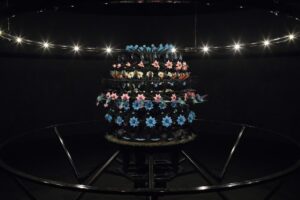
3.《Take Your Time》: A Retrospective of Olafur Eliasson
One of the most influential artists of our time, Olafur Eliasson’s work explores optics, spatial perception, natural phenomena, and the active experience of the viewer, and his 2007 retrospective Take Your Time at SFMOMA travelled to New York, London, and elsewhere, and was named one of the best exhibitions of the year by Time magazine. It travelled to New York and London and was named one of the best exhibitions of the year by Time magazine. The exhibition brought together a representative selection of his work since 1993. From light-filled environments to walk-in kaleidoscopes, his uniquely participatory works offer tantalising spaces for immersive installations, optical experiments, kinetic sculptures, and photographs that challenge perceptions of reality, time, and space.
Eliasson’s work emphasises the viewer’s experience, making viewing a dynamic process rather than a passive reception. Through changes in light, reflection, colour and mirroring, he makes the viewer’s perception unstable, prompting them to contemplate the plasticity of reality. For example, 360º Space, All Colours (2002) immerses the viewer in an ever-changing spectrum of colours, while Moss Wall (1994) uses natural moss to create a ‘living wall’, blurring the boundaries between the natural and the artificial.
The Shaping of Viewing:
While the current theme of the exhibition focuses on how the visual medium defines reality, Take Your Time uses optical installations to make the viewer realise that viewing is not passive, but rather a process of being shaped.
Optics and Visual Manipulation:
For example, The Outside of the Inside (2008) uses colour filters and the residual image effect to allow the viewer to co-create colours, making them aware that colours do not exist objectively, but rather are ‘realities’ that are processed by the brain.
This relates to the logic of the evolution of kaleidoscopic → modern screen technology, and lends itself to your exploration of how visual technology affects the perception of reality.
The Shaping of Reality and Intervention:
Many of the works in the exhibition ‘Take Your Time’ blur the boundaries between reality and perception, leaving the viewer to question, ‘Is what we see real?’
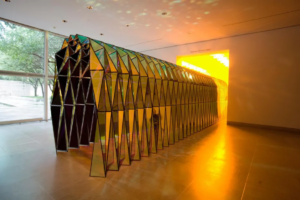
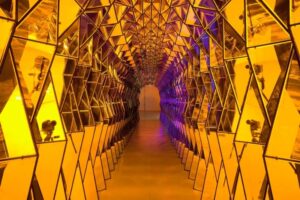
4.Amy Karle–《Regenerative Reliquary, 2016》
Amy Karle is an American artist, bio-artist, and futurist whose work explores the intersection of art, science, and technology, with a focus on how biotechnology affects the human body, society, and future evolution. Her creations integrate biology, artificial intelligence, digital fabrication, and artistic practice, using biomaterials and 3D printing to challenge traditional understandings of the body, consciousness, and “reality.”
Regenerative Reliquary is one of Amy Karle’s most iconic bio-artworks. Using 3D printing technology and stem cell culture experiments, the work attempts to “grow” a human bone in a lab setting. The sculpture is shaped like a human hand bone and made from a biocompatible scaffold designed to support the growth of living cells, eventually forming real bone tissue. This work is both a scientific experiment and an artistic expression, questioning the materiality of life and how biotechnology redefines the boundaries of the “real” human body.
In this work, technology is not just a tool for observing reality but a part of its creation. Karle not only reshapes the body’s form at a visual level but also explores the plasticity of life itself. The work raises profound philosophical questions:
• How does biotechnology change our understanding of life and reality?
• If human bodies can be “manufactured” in a lab, what defines a real body?
• Is technology shifting the definition of “reality” from natural evolution to artificial intervention?
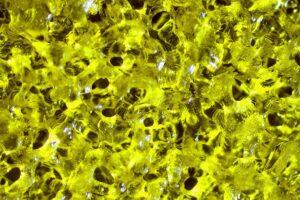
5.Matthew Biederman: ‘Event Horizon’
Event Horizon (2012) is a multichannel generative HD audio/video installation that metaphorically explores the phenomenon of the ‘event horizon’, a boundary in spacetime, such as around black hole, from where light cannot escape and thus cannot be observed. In Event Horizon software iterates through a basic generative system that uses pure fields of Red, Blue, and Green, modulated, layered and interspersed with black. This creates the ‘event horizon’ state where the viewers’ perception, coupled with the technological horizon and the physical space of the installation creates a third image that only exists in the viewer’s mind, calling into question the idea of the horizon, and where perception actually occurs.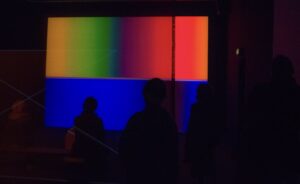
6.Lynn Hershman Leeson–Infinity Engine:
At Stochastic, award-winning artist and filmmaker Lynn Hershman teamed up with NASA scientist Josiah Zayner to produce an epic transmedia artwork. The Infinity Engine encompasses an art installation, an interactive web presence, and a feature film, creating an experience that highlights the urgent and controversial implications of DNA programming. The art installation presents visitors with a replica lab containing 3D bioprinters, microscopes, recorded interviews with genetics experts, and samples of genetically modified organisms. Visitors to the installation are invited to enter “The Scanning Booth,” where a talking computer program attempts to reverse-engineer their genetics based on their physical characteristics. “The Scanning Booth” is powered by custom software written by Josiah that uses computer vision and machine learning to match human features to a genetic database. An online version that will allow web visitors to submit photos of themselves for genetic analysis is in development. “The Scanning Booth” represents the first-ever attempt to reverse-engineer genetics from images of the human face.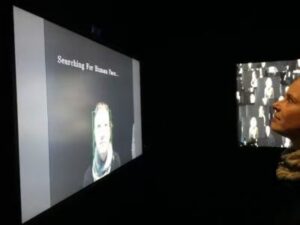
7.Hito Steyerl (b. 1966, Germany) is an artist, writer and filmmaker active in the fields of digital imaging, artificial intelligence, surveillance technology and power structures. Her work focuses on how images shape cognition, how technology controls reality, and how data builds visibility. Often through a combination of humor, parody, and theoretical analysis, Steyerl reveals how contemporary society is influenced by visual technology, capitalism, and political forces. Her work is both a critique of contemporary visual culture and an exploration of the concept of “reality”, especially in the algorithm-driven media environment, where “reality” can be manipulated and reshaped.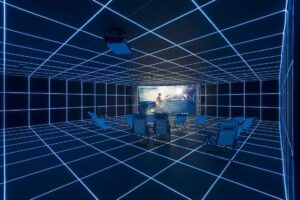
8.The Buddha series, created by artist Nam June Paik, is a multimedia installation that explores the relationship between technology, culture, and art. This series typically consists of a traditional Buddha statue, a television set, and a closed-circuit camera. The Buddha faces the television, while the camera captures its image in real time and displays it on the screen. The closed-circuit camera and television create an infinite feedback loop, a self-referential system that reflects how modern technology shapes our perception.
When a symbol of religious divinity is subjected to unreserved technological observation, the intervention and influence of modern technology on traditional culture and religion become evident. The Buddha gazes at the television, symbolizing the predicament and challenges faced by tradition in the modern information era. The Buddha exists both physically and virtually, blurring the boundaries between reality and digital media. This narrative structure compels the audience to question whether reality remains “real” or has already been reshaped by media.
A traditional Buddha embodies spiritual transcendence, while the Buddha displayed on the television screen is an image constructed by technology. The juxtaposition of the two suggests how technology alters human understanding of the world. In contemporary society, we increasingly perceive reality through screens and images—versions of reality that have been mediated and processed. In this context, “reality” is no longer static or fixed but an ongoing process shaped by technology and human perception, which itself has been restructured by technology.
In an era of rapid media evolution, we must acknowledge that “reality” has long been distorted and blurred in ways we may not even consciously perceive. This media-driven reality challenges traditional philosophical notions and invites deep reflection on contemporary modes of information dissemination.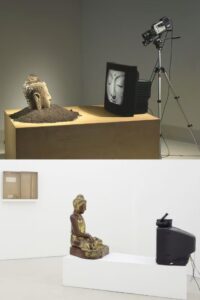
9.teamLab – 《Borderless》
Artist Profile
teamLab is a Japanese interdisciplinary art collective consisting of programmers, engineers, CG animators, mathematicians and architects. They are known for their large-scale interactive digital installations, which focus on breaking down the boundaries between humans and machines, people and space, and encouraging viewers to interact directly with the work using their bodies.
The digital world created by teamLab Borderless is not ‘real’, but through interaction and perception, it allows people to experience the sense of being ‘surrounded by nature’. This immersion constructed by technical means also challenges the audience’s definition of ‘real’ and ‘virtual’. Under the combination of art and technology, the audience is no longer just a viewer, but ‘participates’ in the creative process by moving, touching and interacting. ‘The places you walk, the flowers you touch, all affect the presentation of the work. From this we can see that the ‘audience’ has the right to recreate and define the work to a certain extent.
https://www.teamlab.art/e/jeddah/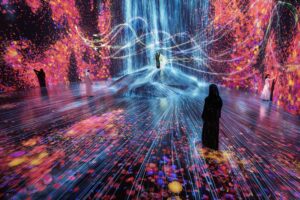
Important Reflection:
1.Visual technologies actively shape the way we perceive reality, rather than simply reflecting it.
2.Scientific advances and digital media have blurred the lines between fact, fantasy and mysticism.
3.Audience participation transforms passive viewing into an interactive, reality-shaping process.
This discussion informs our collective ongoing exploration of perception, interactivity, and the evolving boundaries of reality in contemporary art.














